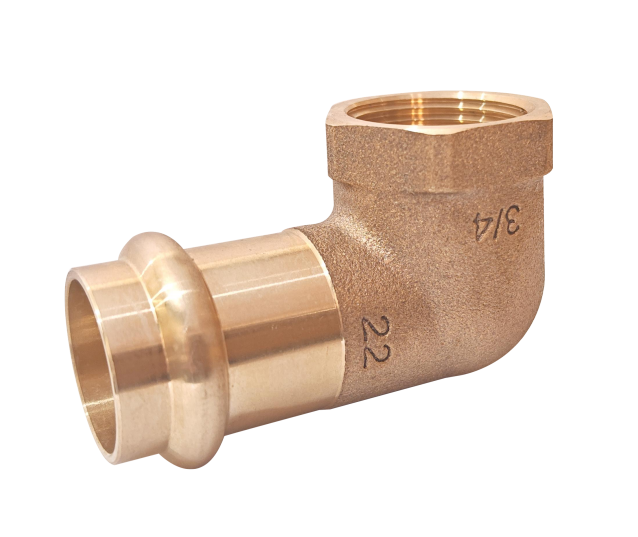A press fit bronze elbow is designed to change the direction of fluid or gas flow in a piping system. It is a type of pipe fitting with a specific angle—usually 90 degrees—that allows pipes to connect at right angles. The structure of a press fit bronze elbow involves several key elements, all of which contribute to its strength and durability.

The primary material used in the manufacture of press fit bronze elbows is bronze, a metal alloy primarily composed of copper, tin, and sometimes other elements like aluminum, phosphorus, or silicon. Bronze is chosen for its corrosion resistance, particularly in water and gas systems, and its ability to withstand high pressures and temperatures. The inclusion of tin enhances the material's resistance to corrosion, while other alloying elements can improve its mechanical properties, such as strength and hardness.
Press fit bronze elbows are typically designed in an “L” shape, with the angle between the two sections of pipe forming a 90-degree bend. This allows the pipe to change direction while maintaining a consistent flow of fluid or gas. The elbow may have a variety of finishes, depending on the application. Some elbows feature smooth, polished surfaces for aesthetic purposes, while others are left in a matte or rougher finish for industrial applications. The diameter of the elbow matches the size of the pipe it is intended to connect, ensuring a tight, leak-free connection.
The press-fit design of the elbow eliminates the need for additional fittings such as threaded connectors or welding, which simplifies the installation process. This design typically includes an internal sleeve or a series of ridges that create a tight seal with the pipe when pressed together, preventing any leakage.
While the press-fit system significantly reduces the need for traditional welding or threading, welding is still an integral part of the production process for press fit bronze elbows, particularly in the formation and assembly of the parts. The welding process helps ensure the structural integrity of the elbow and provides the necessary strength to withstand the pressures and environmental factors to which the elbow will be subjected. Below is a step-by-step overview of the welding process involved in creating press fit bronze elbows.
Before any welding can take place, the materials used to create the bronze elbow must be carefully prepared. This includes ensuring that the bronze alloy is of the correct composition and quality to meet the required standards for the elbow's application. The raw materials are usually cast into rough shapes, which will later be machined into the desired elbow shape. The edges and surfaces of the pieces are cleaned to remove any impurities, such as oxidation, dirt, or grease, to ensure a clean and strong weld.
The welding process used in the creation of press fit bronze elbows often involves techniques such as gas tungsten arc welding (GTAW) or metal inert gas welding (MIG). These welding methods are commonly used in bronze fabrication because they provide precise control over heat and allow for the creation of clean, strong joints.
Gas Tungsten Arc Welding (GTAW): This method, often referred to as TIG (tungsten inert gas) welding, uses a non-consumable tungsten electrode to generate the welding arc. The process uses a shielding gas, typically argon, to protect the weld area from contamination. GTAW is a highly controlled method, making it ideal for welding bronze alloys, as it allows for precise heat application and minimizes the risk of damaging the bronze due to overheating. The technique also ensures that the welds are clean, with minimal spatter or oxidation.
Metal Inert Gas Welding (MIG): In MIG welding, a continuously fed filler wire is used to form the weld joint. A shielding gas, such as argon or carbon dioxide, is used to protect the weld pool from contamination. MIG welding is generally faster than TIG welding and is used when speed and efficiency are priorities. However, the precision of the weld may not be as fine as that achieved with TIG welding. Nevertheless, MIG welding can still provide strong and durable welds for press fit bronze elbows.
 +86-576-82686004
+86-576-82686004
 allen@badavalve.com / daisy@badavalve.com
allen@badavalve.com / daisy@badavalve.com





 EN
EN
 Español
Español










